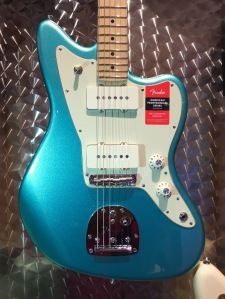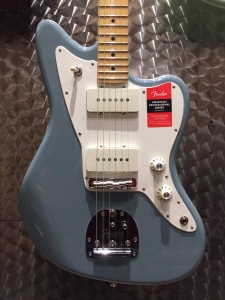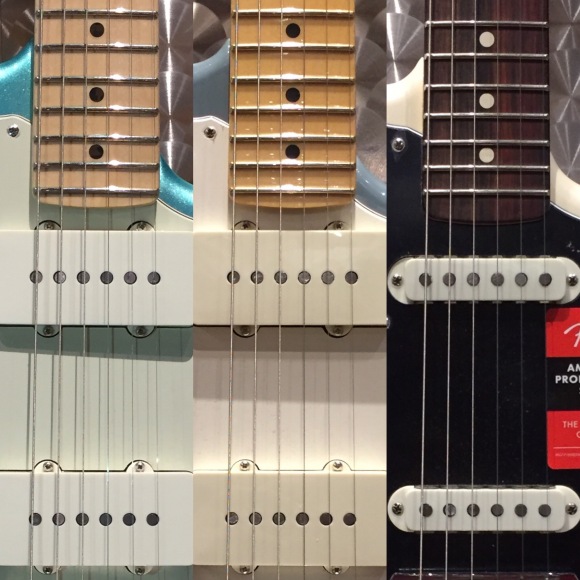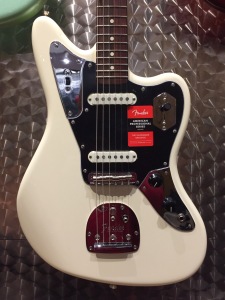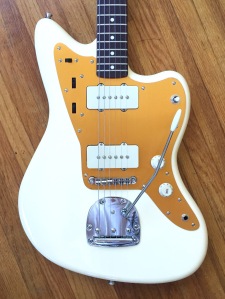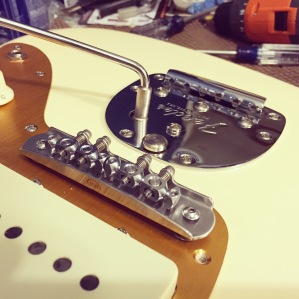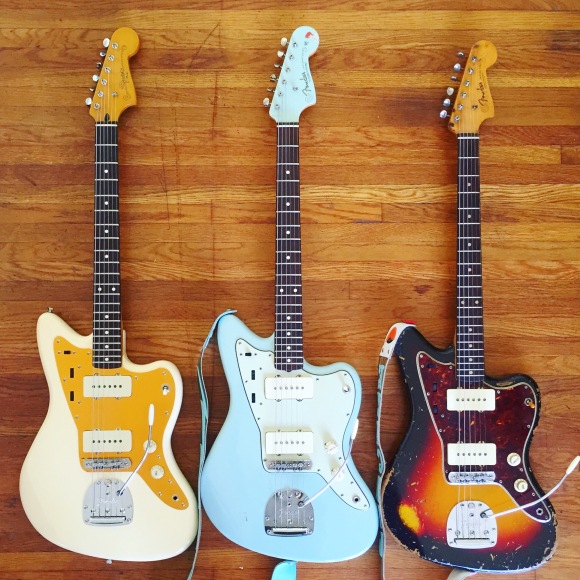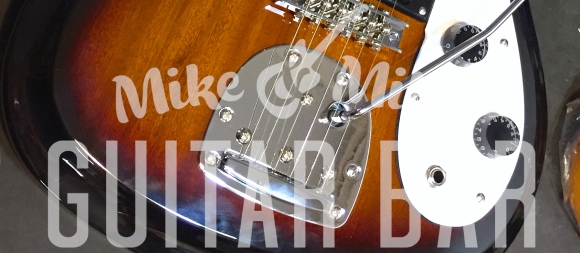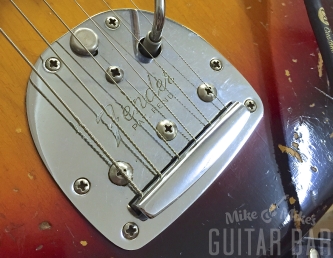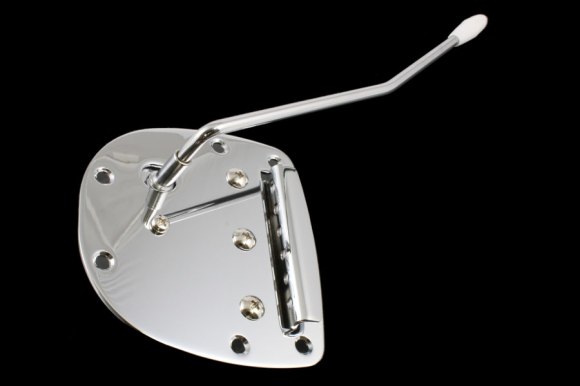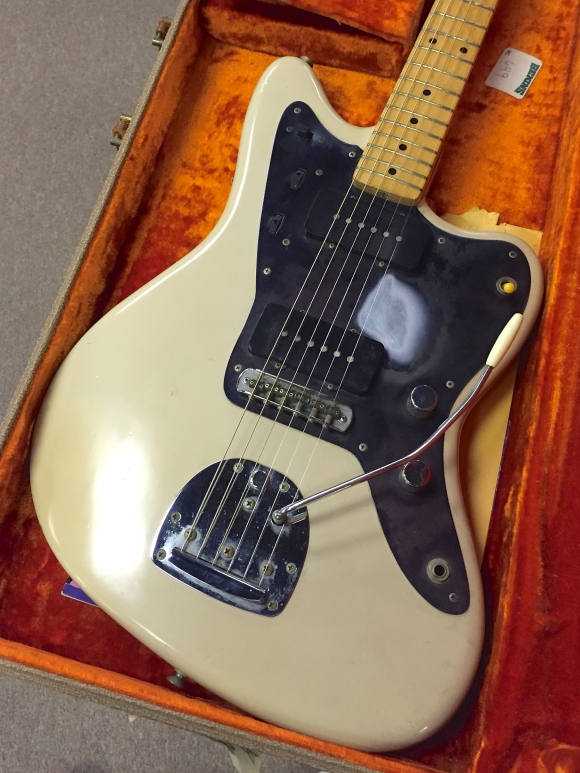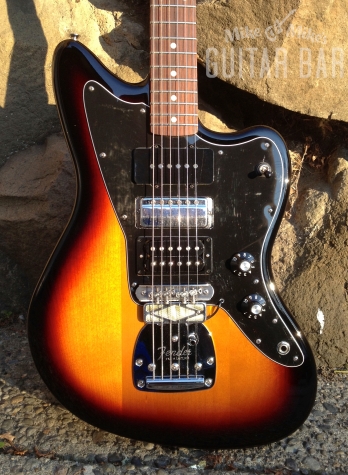 Hate is a strong word, and one I normally don’t like to use unless the subject is foods called “salad” which do not contain lettuce (the only exception being Fruit Salad, but why call it that when ‘Cup of Fruit’ would suffice). While I can’t call my feelings for the Buzz Stop ‘pure hatred,’ I have to admit that removing them from guitars is one of my favorite jobs.
Hate is a strong word, and one I normally don’t like to use unless the subject is foods called “salad” which do not contain lettuce (the only exception being Fruit Salad, but why call it that when ‘Cup of Fruit’ would suffice). While I can’t call my feelings for the Buzz Stop ‘pure hatred,’ I have to admit that removing them from guitars is one of my favorite jobs.
For the uninitiated, the Buzz Stop is an aftermarket bracket for Fender Jazzmasters and Jaguars which acts as a tension bar, much like the roller bar on a Bigsby B7 vibrato. Affixed to the guitar via the forward-facing vibrato mounting screws, the Buzz Stop forces the strings against the bridge, keeping the them in place while also stopping the saddles from buzzing. Hence the name; it stops the buzz.
In theory it’s a fine idea that attempts to solve the problems so many have with the original Fender design, but it’s ultimately completely unnecessary and in many ways a detriment to your guitar’s sound and functionality. Below, you’ll find the reasons I elect to do away with the Buzz Stop, and why I find guitars without them to be better instruments for it.
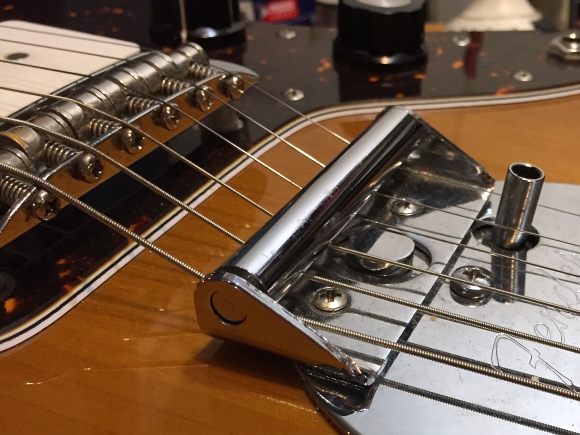
1) The Buzz Stop Introduces New Points of Contact
The whole point of the Buzz Stop is to force the strings down, and in doing so invariably creates additional points of friction. The Buzz Stop’s roller bar is one of those points, and while it is intended to rotate as the vibrato arm is depressed, I’ve never encountered one that actually does so in a smooth manner. Most seem to require a bit of force to turn, more than the strings can dish out. As a result, many of the Stops I’ve removed have had grooves worn in them, which means the strings are just grinding against an immobile roller.
The second point of contact is the back of the bridge itself, a problem that Jazzmasters and Jaguars shouldn’t have to begin with. Under normal circumstances the strings flow from vibrato to bridge uninhibited; the sharp angle of the Buzz Stop causes them to dig into the back edge of the bridge, leading to tuning or even breakage issues. The less metal in the string’s path, the better.
2) Buzz Stops Decrease the Stability of the Vibrato
With its nearly unparalleled stability and smooth feel, the offset vibrato really is one of the biggest selling points of the Jazzmaster and Jaguar. But with the increased friction of a Buzz Stop, it’s a miracle when the thing returns to pitch. Anything that messes with the functionality of the vibrato is a liability, not an asset.

3) It Forces the E Strings onto the Dreaded Pivot Plate Screws
The vibrato pivot plate mounting screws which sit directly beneath the two E strings have long been a problem on reissue guitars, causing string breaks and tuning issues which can normally be cured with a proper setup and increased bridge height, or by simply turning them upside down as shown in one of the early Demystifying articles.
With a Buzz Stop installed, there simply is no hope for the strings (See above). Pulled down toward the vibrato plate, the Es are forced against those pesky domed screws. As they’re bent, tuned, or warbled with the vibrato, the screws eventually saw through the string’s finish wrap leading to sharp detuning, and eventually, breakage.
4) The Buzz Stop Alters the Guitar’s Unique Vibe
Part of the unique sound of Jaguars and Jazzmasters is the length of string behind the bridge. Like an archtop acoustic, every bit of vibration counts. There’s a fullness and a pluckiness to the tone that comes from the added string length, and the slight decrease in sustain and tension makes these guitars feel and respond unlike other solidbody electrics. It should be no surprise that I also wholly endorse vigorous picking behind the bridge for atonal, noisy fun.
With a Buzz Stop installed, you may as well have a stop tail. It effectively cancels out the length of string behind the bridge, sterilizing some of the three-dimensional resonance that make these guitars sing. And honestly, if you’re looking for more sustain or ‘better tone’ there are far better options available to you in the form of Mastery and Staytrem hardware.
5) It’s a Half Measure Response
The Buzz Stop is a product of a time when these guitars were thought of as toys rather than fully-playable instruments. Without the readily-available, conversational sources for setup and modification that we have today (including this blog and my recent Premier Guitar article) the Buzz Stop was perhaps a once-legitimate option for taming this misunderstood, often neglected offset design. Though its premise was flawed, it served its purpose.

The Buzz Stop, by its very nature, doesn’t really “fix” anything; it’s a stopgap which fails to address core issues, applying force instead of correcting an inadequate setup. All of the common complaints, from bridge buzz and string jumping, tuning stability, and unwanted string resonance are easily solved with an attentive eye, a couple of screwdrivers, and a few hex keys. Neck angle, bridge height, string gauge––all of these things are integral to the design of the guitar, some of which the Buzz Stop website actively recommends against.
With advent of the internet, players now know how to care for the Jazzmaster and Jaguar better than they ever have. Communities like Offset Guitar Forum and Shortscale.org popped up and thrived, surrounding the Jazzmaster and Jaguar with that perfect, geeky love that reminiscent of my fellow Star Trek fans, excitedly swapping tips and parts, digging into manuals and other documents to discover the proper way to work on them.
6) It’s Ugly
It is. Don’t @ me.
The Long Walk into the Sunset
Call me a pedant, call me a purist, even call me ol’ Henry’s favorite, “luddite”––I just think we have so many better options for modifying or ‘fixing’ these instruments, all of which leave the original sound and intent largely intact. And honestly, in every instance where I’ve removed a Buzz Stop and then properly set up the guitar, it just sounds better to me.
We used to joke at the old shop about a cardboard box tucked away in the back that was filled with forty discarded Buzz Stops. We’d always say “forty” for some reason––We have forty of them in a box!––but thinking back that number has to be low. Literally every time we took in a new Jaguar or Jazzmaster bearing one, off it would come, fate sealed, tossed with prejudice into said box never to be seen or thought of again. And that’s just the way we like it.






 Fender began sending them out to musicians and social media stars late in the year (where’s the love?!) but kept quiet about specs. Much of what was known about the models was deduced by blowing up blurry Instagram photos and leaked catalogue pages. Excitement soared, and soon I was buried under requests for The Jazzmaster Guy’s take on the new models.
Fender began sending them out to musicians and social media stars late in the year (where’s the love?!) but kept quiet about specs. Much of what was known about the models was deduced by blowing up blurry Instagram photos and leaked catalogue pages. Excitement soared, and soon I was buried under requests for The Jazzmaster Guy’s take on the new models.